What It Becomes | Art & Artists
Aug 24, 2024–Jan 12, 2025
What It Becomes | Art & Artists
Blythe Bohnen
2
Blythe Bohnen once expressed that she was “interested in [herself] as a mark-making person.” In this series of self-portraits, Bohnen used her eyes as drawing tools. After setting up a camera to take long-exposure photographs, she positioned herself in front of the lens and carefully moved her head in various choreographed motions. In the resulting images, the highlights in her eyes are recorded as thin white lines that trace patterns and shapes determined by her movements, while the rest of her face dissolves into a blur. Bohnen enjoyed that the act of drawing in this way rendered her unrecognizable: “Through this systematic and simple process . . . I can become a man or a woman, or a series of different human characters. . . . I can be standing beside my portrait, but nobody can recognize the subject (myself).”

